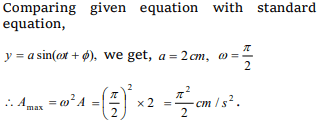1. The displacement of an oscillating particle varies
with time (in seconds) according to the equation \[y\left( cm \right)=\sin\frac{\pi}{2}\left(\frac{t}{2}+\frac{1}{3}\right)\] . The maximum acceleration
of the particle is approximately
a) 5.21 cm / \[s^{2}\]
b) 3.62 cm / \[s^{2}\]
c) 1.81 cm / \[s^{2}\]
d) 0.62 cm / \[s^{2}\]
Explanation:

2.A particle moving along the x-axis executes
simple harmonic motion, then the force acting on
it is given by
a) – A Kx
b) A cos (Kx)
c) A exp (– Kx)
d) A Kx
Explanation:

3.A body is vibrating in simple harmonic motion
with an amplitude of 0.06 m and frequency of 15
Hz. The velocity and acceleration of body is
a) 5.65 m/s and 5.32 \[\times 10^{2}m/s^{2}\]
b) 6.82 m/s and 7.62 \[\times 10^{2}m/s^{2}\]
c) 8.91 m/s and 8.21 \[\times 10^{2}m/s^{2}\]
d) 9.82 m/s and 9.03 \[\times 10^{2}m/s^{2}\]
Explanation:

4. A particle executes harmonic motion with an
angular velocity and maximum acceleration of 3.5
rad/sec and 7.5 m \[/s^{2}\] respectively. The amplitude
of oscillation is
a) 0.28 m
b) 0.36 m
c) 0.53 m
d) 0.61 m
Explanation:

5. A 0.10 kg block oscillates back and forth along a
horizontal surface. Its displacement from the
origin is given by: x =(10 cm) cos [ (10 rad/s) t + \[\pi\] /2 rad]
.
What is the maximum acceleration experienced by
the block
a) 10 m/ \[s^{2}\]
b) 10 \[\pi m/s^{2}\]
c) \[\frac{10\pi}{2}\] \[m/s^{2}\]
d) \[\frac{10\pi}{3}\] \[ m/s^{2}\]
Explanation:

6.A particle is executing simple harmonic motion
with an amplitude of 0.02 metre and frequency 50
Hz. The maximum acceleration of the particle is
a) 100 m/ \[s^{2}\]
b) 100 \[\pi^{2} m/s^{2}\]
c) 200 m/\[s^{2}\]
d) 200 \[\pi^{2} m/s^{2}\]
Explanation:

7.Which one of the following statements is true for
the speed v and the acceleration a of a particle
executing simple harmonic motion
a) When v is maximum, a is maximum
b) Value of a is zero, whatever may be the value
of v
c) When v is zero, a is zero
d) When v is maximum, a is zero
Explanation:

8. What is the maximum acceleration of the particle
doing the SHM \[y=2 \sin\left[\frac{\pi t}{2}+\phi\right]\]
where 2 is in cm
a) \[\frac{\pi}{2} cm/s^{2}\]
b) \[\frac{\pi^{2}}{2} cm/s^{2}\]
c) \[\frac{\pi}{4} cm/s^{2}\]
d) \[\frac{\pi}{4} cm/s^{2}\]
Explanation:

9. A particle executes linear simple harmonic motion
with an amplitude of 2 cm. When the particle is at
1 cm from the mean position the magnitude of its
velocity is equal to that of its acceleration. Then
its time period in seconds is
a) \[\frac{1}{2\pi\sqrt{3}}\]
b) \[2\pi\sqrt{3}\]
c) \[\frac{2\pi}{\sqrt{3}}\]
d) \[\frac{\sqrt{3}}{2\pi}\]
Explanation:

10. In simple harmonic motion, the ratio of
acceleration of the particle to its displacement at
any time is a measure of
a) Spring constant
b) Angular frequency
c) (Angular frequency)2
d) Restoring force
Explanation:
